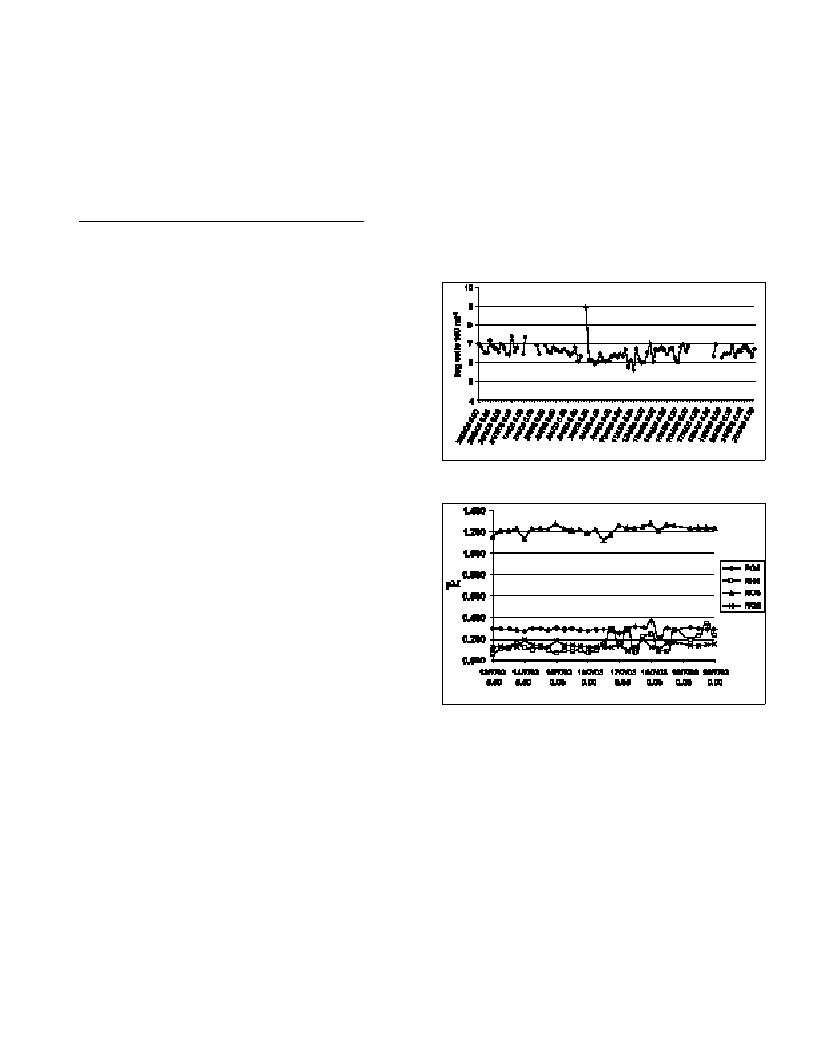Rapp. Comm. int. Mer Médit., 37,2004
154
MULTIPARAMETRIC MARINE MONITORING FROM AUTOMATIC COASTAL PLATFORMS
Zappalà G.*, Caruso G., Azzaro F., CrisafiE.
CNR - Istituto per l’Ambiente Marino Costiero (IAMC) – Section of Messina, Italy - * zappala@ist.me.cnr.it
Abstract
New devices were developed in the framework of the Italian MIUR Cluster 10 programme to fulfil the need for low-cost, reliable,
automatic systems for coastal marine monitoring. The main device is a system acquiring and transmitting in real time physical, chemical
and physico-chemical parameters of seawater together with meteorological observations, able also to control an automatic water
multisampler for off-line bacteriological determinations. Measuring systems are hosted in seven platforms, moored in selected Sicilian and
Apulian sites, which are affected by anthropic, urban or industrial inputs. Some data acquired by two of these platforms are here presented.
Keywords: Monitoring, coastal area, Mediterranean Sea
Introduction
Improvement in the technological instrumentation and equipment
for coastal monitoring represents the challenge for future
development in the field of environmental assessment. In the last
decade, advanced devices have recently been designed to be used as
components in networks of multiparametric observation systems (1).
The paper describes two examples of application of our automatic
monitoring platforms, showing their capability to evaluate both the
trophic condition of a coastal site, as performed in a Tyrrhenian
ecosystem, and the anthropic input in a semi-enclosed area, as in
Messina harbour.
Materials and methods
Measured Parameters
Measurements were performed by two platforms (2), hosting a
system that pumps water samples from five depths into a measurement
chamber where a IM50 CTDO probe with fluorometer and
turbidimeter is fitted; the same water is also used to feed a Systea
Nutrient Probe Analyser and a bacteriological multisampler
expressely designed to store and fix eight 250 ml samples. The
temperature at the sampling depths was measured by five SBE39 in
situprobes. A meteorological station equipped with temperature,
pressure, solar radiance, wind direction and speed sensors completed
the equipment present in all platforms.
Messina platform also included an IM50 probe for in situ
subsurface measurements and an Aquadopp 600 ADCP.
All the measuring operations were controlled by an expressely
designed data acquisition and transmission system, fully manageable
and reprogrammable via GSM and SMS, transmitting the acquired
data via e-mail in real time.
Studied area
The Gulf of Milazzo is a coastal Tyrrhenian area receiving
consistent continental out?ow and is characterised by an anticyclonic
water circulation. Due to its past tendency towards the eutrophy, this
area was monitored for the main hydrological parameters
(temperature, conductivity, dissolved oxygen, nutrients) driving
biological processes (3). The Straits of Messina, a transition area
between Ionian and Tyrrhenian waters, are characterized by two main
alternating currents, called “montante”, from the Ionian Sea
northwards, and “scendente”, from the Tyrrhenian Sea southwards.
Water circulation is affected by this continuous water mass exchange;
microbial pollution was monitored in this area, where different
sewages are discharged along the shoreline (4).
Results
Nutrient measurements performed on subsurface samples using the
NPA in Milazzo Platform are reported in Fig. 1. During the period
examined, no significant variations were found; ammonia, nitrites and
orthophosphates showed low concentrations, while substantially high
nitrates values were measured.
Total bacterioplankton counts by DAPI staining (Fig. 2), obtained
in surface samples collected in Messina harbour by the automatic
multisampler, showed a quite regular course, with repeated peaks at
6.00 a.m. on the first sampling days, and then shifted 6 hours later in
the successive days. This might be explained by the arrival of high
amounts of organic matter, such as those drawn from the alternating
“scendente” and “montante” currents, that stimulated bacterial
growth.
Discussion
The systems here described proved to be reliable tools for the
monitoring of coastal environment; their real time capability enables
to use them in the management of natural resources and protection of
environmental quality level (nowcasting and early warning). The
ability to acquire long-term time series allows the development of
forecasting models.
Fig. 1. Nutrients in Milazzo Gulf
Fig. 2. Bacterioplankton density in Messina harbour
Acknowledgements. Work funded by the MIUR Cluster 10 SAM
research programme
References
1-Zappalà, G., Caruso, G., & Crisafi, E., 2002. Design and use of
advanced technology devices for sea water monitoring. In: Flemming
N.C., Vallerga S., Pinardi N., Behrens H.W.A., Manzella G., Prandle D.,
Stel J.H. (eds.), Operational Oceanography. Implementation at the
European and Regional Scales. Elsevier Oceanography Series, 66.
2-Zappalà, G., Caruso, G., Azzaro, F., & Crisafi, E., 2003. Integrated
Environment Monitoring from Coastal Platforms. Pp. 2007-2018. In: Proc
Int. Conf. On the Mediterranean Coastal Environment, MEDCOAST03.
3-Decembrini F., Azzaro F., Galletta M. G., Raffa F., 2004. Short-term
changes of hydrobiological features in the Gulf of Milazzo (Tyrrhenian
Sicily). Rapp. Comm. int. Mer Medit. this issue.
4-Zappalà G., CrisafiE., Caruso G., Azzaro F., Magazzù G., 1998.
Coastal monitoring by an advanced technology platform. Pp. 69-84. In:
Proc. Oceanology International ’98 Conference.

